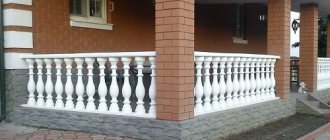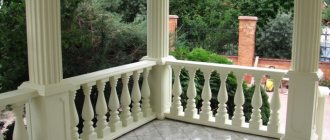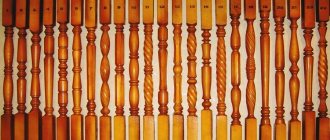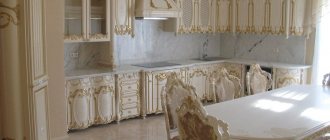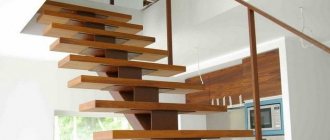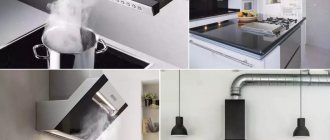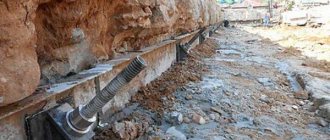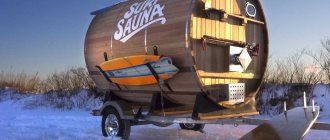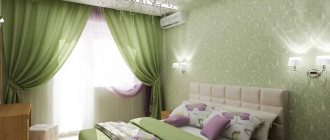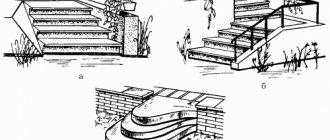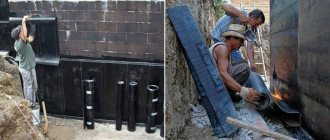Beautiful balusters are the main architectural element in the design of the staircase. These parts allow you to keep the railing upright.
Most often they are used as a support, which allows you to create a strong structure for lifting upwards.
During the manufacturing process, various technological features of industrial production are used.
Finished products have an attractive and aesthetic appearance that can fit into any design direction.
Functions of balusters
Sometimes railings for stairs made of stainless steel or other metals are installed without the use of balusters. The basis for them are racks. In structures without handrails, such elements are not needed at all. But if the house is equipped with a stationary staircase, it is worth using all the elements in the design.
Balusters perform decorative and practical functions. Their availability:
- provides the stairs with additional stability and rigidity;
- gives the design the necessary safety and ease of use;
- makes the design of the building attractive and harmonious.
Balusters perform decorative and practical functions
Various materials are used to create elements. You can use standard products or place an order for production according to exclusive sketches. By wisely choosing balusters for stairs made of metal or wood, you can make them the main decoration of the structure and interior of the room.
Prices and sizes of ash balusters
| Type | Size (mm) | Price |
| №12 | Initial column 80x80x1200 | 3000 rub. |
| Initial column 100x100x1200 | 3800 rub. | |
| Baluster 50x50x900 | 750 rub. | |
| Baluster 60x60x900 | — | |
| №16 | Initial column 80x80x1200 | 3000 rub. |
| Initial column 100x100x1200 | 3800 rub. | |
| Baluster 50x50x900 | 750 rub. | |
| Baluster 60x60x900 | — |
Materials in the manufacture of balusters
These elements are installed in street and home structures of various types. When choosing material for balusters, all the features of the staircase and the specific operation are taken into account. They can be made from:
- natural or artificial stone;
- gypsum;
- polymers;
- concrete;
- glass;
- metal;
- tree.
Balusters for wooden stairs
Stone and concrete elements are used in monumental, monolithic structures. Such balusters support massive railings, enclosing portals, open areas, porches, balconies, etc. These products are heavy and require a reinforced base.
Stone balusters are used in monumental structures
Balusters for stairs located in a private house are most often made of metals and wood. You can use gypsum products if they suit the style of the interior. The choice of material depends on the features of the staircase design and the style in which the room is decorated.
Light metal balusters
Prices and sizes of larch balusters
| Type | Size (mm) | Price |
| №3 | Initial post, larch, 80x80x1200 | 1470 rub. |
| Initial post, larch, 100x100x1200 | 2100 rub. | |
| Baluster, larch, 50x50x900 | 460 rub. | |
| №6 | Initial post, larch, 80x80x1200 | 1470 rub. |
| Initial post, larch, 100x100x1200 | 2100 rub. | |
| Baluster, larch, 50x50x900 | 460 rub. | |
| №12 | Initial post, larch, 80x80x1200 | 1470 rub. |
| Initial post, larch, 100x100x1200 | 2100 rub. | |
| Baluster, larch, 50x50x900 | 460 rub. | |
| №16 | Initial post, larch, 80x80x1200 | 1470 rub. |
| Initial post, larch, 100x100x1200 | 2100 rub. | |
| Baluster, larch, 40x40x900 | 340 rub. | |
| Baluster, larch, 50x50x900 | 460 rub. |
Types of metal elements
Installation of railings made of stainless steel and other metals is usually performed on balusters made of the same material. This provides the structure with a harmonious appearance and ease of installation. There are several types of metal support elements:
- rolled metal parts;
- cast products;
- forged balusters.
In the manufacture of supporting elements, rolled metal of round and square cross-section is used. The aesthetic indicators of such balusters are low. They are rarely used in private homes; they can complement simple street structures.
Cast products imitate artistic forging. The elements can have any shape, giving the staircase a noble, solid look. The disadvantage of such products is the lack of originality. These are mass products with little variety.
Balusters for stairs with elements of artistic forging
Forged balusters are a priori unique. Masters of artistic forging create products based on exclusive sketches. They are developed for a specific staircase, exactly matching its design and style. Such elements are quite expensive. But the costs for them are justified by impeccable aesthetic indicators and respectability.
Various metals are used in the manufacture of products. A common, inexpensive option is carbon steel. Used in the creation of balusters and cast iron. This is a durable, extremely durable material. But the large weight of the products limits their use. Balusters and stainless steel stair railings are an excellent option for creating a modern interior. This material has excellent technological and aesthetic characteristics.
Stainless steel balusters for modern interiors
Prices and sizes of oak balusters
| Type | Size (mm) | Price |
| №3 | Initial column, oak, 80x80x1200 | 3000 rub. |
| Initial column, oak, 100x100x1200 | 3800 rub. | |
| Baluster, oak, 50x50x900 | 750 rub. | |
| №6 | Initial column 80x80x1200 | 3000 rub. |
| Initial column 100x100x1200 | 3800 rub. | |
| Baluster 50x50x900 | 750 rub. | |
| №14 | Initial column, oak, 80x80x1200 | 3000 rub. |
| Initial column, oak, 100x100x1200 | 3800 rub. | |
| Baluster, oak, 50x50x900 | 750 rub. | |
| №16 | Initial column 80x80x1200 | 3000 rub. |
| Initial column 100x100x1200 | 3800 rub. | |
| Baluster 40x40x900 | 480 rub. | |
| Baluster 50x50x900 | 750 rub. |
Wooden balusters for stairs
Wooden balusters are very popular. These elements successfully complement classic styles, country, Provence, etc. Various types of wood are used in production. You can purchase items from:
- oak,
- beech,
- pine trees,
- birch trees
- larches,
- ash
Wooden balusters will fit well into the classic style of the interior
Wood has different shades and qualities. When choosing products, you will have to take into account financial capabilities. Oak and beech balusters will require significant expenses. You can purchase inexpensive models made of pine and imitate valuable species using tinting.
Several technologies are used to create balusters. Elements of simple shape are made on lathes. Milling equipment makes it possible to obtain more complex designs with figured cuts. The most expensive technology is hand carving. Nowadays CNC machines are used in woodworking. This equipment performs carvings no worse than a skilled craftsman, but the cost of such products is lower.
Luxurious carved wooden balusters
Prices and sizes of initial “Box” posts
| Type | Size (mm) | Price |
| №1 | Initial column “Box” (not hollow) No. 1, larch, 135x135x1150 | 4500 rub. |
| Initial column “Box” (not hollow) No. 1, oak, 140x140x1250 | 4800 rub. | |
| №3 | Initial column “Box” (not hollow) No. 3, oak, 140x140x1250 | 5800 rub. |
| Initial column “Box” (not hollow) No. 3, oak, 160x160x1250 | 8000 rub. | |
| №3 | Initial column “Box” (not hollow) No. 3, larch, 135x135x1150 | 4500 rub. |
| Initial column “Box” (not hollow) No. 3, larch, 155x155x1250 | 7200 rub. | |
| №3 | Initial post “Box” (not hollow) No. 3, pine, 135x135x1150 | 3500 rub. |
| Initial post “Box” (not hollow) No. 3, pine, 155x155x1250 | 4500 rub. | |
| Platform for the starting post | To order , Pine, On a pole: 80x80; 100x100; 120x120; 150x150; 200x200; etc. Thickness: 18; 28; 40. | from 200 rub. |
| To order , Larch, On a pole: 80x80; 100x100; 120x120; 150x150; 200x200; etc. Thickness: 18; 28; 40 | from 350 rub. | |
| To order , Oak, On a pole: 80x80; 100x100; 120x120; 150x150; 200x200; etc. Thickness: 20; thirty; 40. | from 500 rub. |
Other materials in creating balusters
Balusters for stairs and fences located outdoors must have increased strength and resistance to climatic influences. In the creation of massive structures, stone and concrete supporting elements are often used. They withstand high loads and maintain integrity in any conditions.
Stone balusters are used for outdoor stairs
Polymer elements are now often used in the design of stairs. Most often, balusters are made of acrylic and polyurethane. These materials are ideally molded; products can be given any desired shape. A significant advantage is the ability to give the balusters the desired shade. The advantages of such support elements include:
- resistance to any impact;
- minimum weight;
- decent aesthetic indicators;
- easy care;
- durability;
- low price.
Acrylic balusters are resistant to any impact
Plaster is used to create balusters. This is an environmentally friendly, strong and durable material. Gypsum elements fit perfectly into classical styles, Empire, Provence, etc.
Plaster balusters fit perfectly into the classic style
Glass is becoming increasingly popular. The emergence of durable, safe triplex made it possible to design any structure in an original, stylish way. Most often, stainless steel railings are installed on such supports. These materials are ideally combined and fit harmoniously into modern styles.
Harmonious combination of stainless steel railings and glass balusters
Prices and sizes of pine balusters
| Type | Size (mm) | Price |
| №1 | Initial column 80x80x1200 | 950 rub. |
| Initial column 100x100x1200 | 1360 rub. | |
| Initial column 120x120x1200 (to order) | 3180 rub. | |
| Initial column 150x150x1200 (to order) | 4100 rub. | |
| Baluster 50x50x900 | 250 rub. | |
| Baluster 60x60x900 | 340 rub. | |
| Baluster 80x80x900 (to order) | 950 rub. | |
| Baluster 100x100x900 (to order) | 1360 rub. | |
| Baluster 120x120x1000 (to order) | 3180 rub. | |
| Baluster 150x150x1000 (to order) | 4100 rub. | |
| №2 | Initial column 80x80x1200 (to order) | 950 rub. |
| Initial column 100x100x1200 (to order) | 1360 rub. | |
| Initial column 120x120x1200 (to order) | 3180 rub. | |
| Initial column 150x150x1200 (to order) | 4100 rub. | |
| Baluster 50x50x900 | 250 rub. | |
| Baluster 60x60x900 | 340 rub. | |
| Baluster 80x80x900 (to order) | 950 rub. | |
| Baluster 100x100x900 (to order) | 1360 rub. | |
| Baluster 120x120x1000 (to order) | 3180 rub. | |
| Baluster 150x150x1000 (to order) | 4100 rub. | |
| №3 | Initial column 80x80x1200 | 950 rub. |
| Initial column 100x100x1200 | 1360 rub. | |
| Initial column 120x120x1200 (to order) | 3180 rub. | |
| Initial column 150x150x1200 (to order) | 4100 rub. | |
| Baluster 50x50x900 | 250 rub. | |
| Baluster 60x60x900 | 340 rub. | |
| Baluster 80x80x900 (to order) | 950 rub. | |
| Baluster 100x100x900 (to order) | 1360 rub. | |
| Baluster 120x120x1000 (to order) | 3180 rub. | |
| Baluster 150x150x1000 (to order) | 4100 rub. | |
| №4 | Initial column 80x80x1200 | 950 rub. |
| Column 100x100x1200 | 1360 rub. | |
| Post 120x120x1200 (to order) | 3180 rub. | |
| Post 150x150x1200 (to order) | 4100 rub. | |
| Baluster 50x50x900 | 250 rub. | |
| Baluster 60x60x900 | 340 rub. | |
| Baluster 80x80x900 (to order) | 950 rub. | |
| Baluster 100x100x900 (to order) | 1360 rub. | |
| Baluster 120x120x1000 (to order) | 3180 rub. | |
| Baluster 150x150x1000 (to order) | 4100 rub. | |
| №5 | Initial column 80x80x1200 | 950 rub. |
| Initial column 100x100x1200 | 1360 rub. | |
| Initial column 120x120x1200 (to order) | 3180 rub. | |
| Initial column 150x150x1200 (to order) | 4100 rub. | |
| Baluster 50x50x900 | 250 rub. | |
| Baluster 60x60x900 | 340 rub. | |
| Baluster 80x80x900 (to order) | 950 rub. | |
| Baluster 100x100x900 (to order) | 1360 rub. | |
| Baluster 120x120x1000 (to order) | 3180 rub. | |
| Baluster 150x150x1000 (to order) | 4100 rub. | |
| №6 | Initial column 80x80x1200 | 950 rub. |
| Initial column 100x100x1200 | 1360 rub. | |
| Initial column 120x120x1200 (to order) | 3180 rub. | |
| Initial column 150x150x1200 (to order) | 4100 rub. | |
| Baluster 50x50x900 | 250 rub. | |
| Baluster 60x60x900 | 340 rub. | |
| Baluster 80x80x900 (to order) | 950 rub. | |
| Baluster 100x100x900 (to order) | 1380 rub. | |
| Baluster 120x120x1000 (to order) | 3180 rub. | |
| Baluster 150x150x1000 (to order) | 4100 rub. | |
| №9 | Initial column 80x80x1200 | 950 rub. |
| Initial column 100x100x1200 | 1360 rub. | |
| Initial column 120x120x1200 (to order) | 3180 rub. | |
| Initial column 150x150x1200 (to order) | 4100 rub. | |
| Baluster 50x50x900 | 250 rub. | |
| Baluster 60x60x900 | 340 rub. | |
| Baluster 80x80x900 (to order) | 950 rub. | |
| Baluster 100x100x900 (to order) | 1360 rub. | |
| Baluster 120x120x1000 (to order) | 3180 rub. | |
| Baluster 150x150x1000 (to order) | 4100 rub. | |
| №10 | Initial column 80x80x1200 | 950 rub. |
| Initial column 100x100x1200 | 1360 rub. | |
| Initial column 120x120x1200 (to order) | 3180 rub. | |
| Initial column 150x150x1200 (to order) | 4100 rub. | |
| Baluster 50x50x900 | 250 rub. | |
| Baluster 60x60x900 | 340 rub. | |
| Baluster 80x80x900 (to order) | 950 rub. | |
| Baluster 100x100x900 (to order) | 1360 rub. | |
| Baluster 120x120x1000 (to order) | 3180 rub. | |
| Baluster 150x150x1000 (to order) | 4100 rub. | |
| №11 | Initial column 80x80x1200 | 950 rub. |
| Initial column 100x100x1200 | 1360 rub. | |
| Initial column 120x120x1200 (to order) | 3180 rub. | |
| Initial column 150x150x1200 (to order) | 4100 rub. | |
| Baluster 50x50x900 | 250 rub. | |
| Baluster 60x60x900 | 340 rub. | |
| Baluster 80x80x900 (to order) | 950 rub. | |
| Baluster 100x100x900 (to order) | 1360 rub. | |
| Baluster 120x120x1000 (to order) | 3180 rub. | |
| Baluster 150x150x1000 (to order) | 4100 rub. | |
| №12 | Initial column 80x80x1200 | 950 rub. |
| Initial column 100x100x1200 | 1360 rub. | |
| Initial column 120x120x1200 (to order) | 3180 rub. | |
| Initial column 150x150x1200 (to order) | 4100 rub. | |
| Baluster 50x50x900 | 250 rub. | |
| Baluster 60x60x900 | 340 rub. | |
| Baluster 80x80x900 (to order) | 950 rub. | |
| Baluster 100x100x900 (to order) | 1360 rub. | |
| Baluster 120x120x1000 (to order) | 3180 rub. | |
| Baluster 150x150x1000 (to order) | 4100 rub. | |
| №16 | Initial column 80x80x1200 | 950 rub. |
| Initial column 100x100x1200 | 1360 rub. | |
| Initial column 120x120x1200 (to order) | 3180 rub. | |
| Initial column 150x150x1200 (to order) | 4100 rub. | |
| Baluster 50x50x900 | 250 rub. | |
| Baluster 60x60x900 | 340 rub. | |
| Baluster 80x80x900 (to order) | 950 rub. | |
| Baluster 100x100x900 (to order) | 1360 rub. | |
| Baluster 120x120x1000 (to order) | 3180 rub. | |
| Baluster 150x150x1000 (to order) | 4100 rub. | |
| Ampil | Initial column 100x100x1200 | 2200 rub. |
| Baluster 60x60x900 | 650 rub. | |
| Baluster 80x80x900 (to order) | 1800 rub. | |
| Baluster 100x100x900 (to order) | 2200 rub. |
Calculations for selection and installation of balusters
Home craftsmen who decide to install a staircase themselves need to know the rules for choosing elements, how to fasten balusters on a wooden staircase or metal structure.
The length of the elements depends on the height of the railing. Standard handrails are installed at a distance of 70-100 centimeters from the steps. You can adjust the standard indicators if the residents of the house are tall. The height of the baluster is calculated by subtracting the thickness of the railing from the total height of the handrail. For children, you can equip the stairs with additional railings.
Calculations for selecting balusters
The required number of balusters depends on the length of the stairs. It is not worth saving on the purchase of elements due to the large distance between the supports. The structure must first and foremost be safe. It is especially important to carefully observe the size of the gaps if there are small children in the house. The standard distance between balusters is 15 centimeters.
An example of calculating the number of balusters
Dimensions and prices for blanks for balusters and initial posts
| Size (mm) | Price | |||||||
| Oak cat. "A" | Oak cat. "E" | Ash cat. "A" | Ash cat. "E" | Larch cat. "A" | Larch cat. "E" | Beech cat. "A" | Beech cat. "E" | |
| 50x50x900 | 500 rub. | — | — | — | 300 rub. | 280 rub. | — | 410 rub. |
| 60x60x900 | 660 rub. | — | — | — | — | — | — | — |
| 80x80x1200 | 1850 rub. | — | 1260 rub. | — | 900 rub. | 950 rub. | — | — |
| 100x100x1200 | 2500 rub. | — | 1860 rub. | — | 1300 rub. | 1350 rub. | — | — |
| 120x120x1200 | 3000 rub. | — | — | — | — | — | — | — |
Principles for choosing balusters for stairs
When choosing balusters for stairs, you need to consider several criteria:
- the material from which supports, steps, railings are made;
- design style of stairs, house interior;
- financial opportunities.
Wooden supports look attractive, especially if they are figured, carved elements. The shades and texture of wood invariably bring comfort and warmth to the atmosphere of the house. Staircases with such balusters look ideal in the following styles: country, rustic, rustic. You can use this technique to decorate Provence, modern, eco, and classic.
Wooden balusters for stairs add coziness to the atmosphere of your home
Balusters for stairs made of metal have many advantages. These products:
- have high strength and long service life;
- not demanding on conditions;
- do not require complex care.
Thanks to the variety of materials and manufacturing technologies, you can choose such elements for any interior. Metal supports add lightness to the structure; they go well with wooden steps and railings. For example, forged and cast balusters are widely used in classical, modern, and other styles. Their combination with railings and wooden steps guarantees the staircase a respectable appearance.
Metal balusters add lightness to the staircase
Metal stairs are often installed in modern interiors. If you plan to install stainless steel railings, glass can be used as a support. It can be transparent or matte, tinted, corrugated. Decor is often created on glass fences, providing the interior with uniqueness and impeccable harmony.
Stainless steel railings use glass as support
If you need to add grandeur and luxury to the atmosphere, you can use plaster balusters. Any structures can be made from this material. There is an opportunity to make them yourself or order them from professionals. Plaster elements can be painted to ensure a harmonious combination with the interior.
Those wishing to decorate an original interior should pay attention to balusters made of transparent acrylic. LEDs can be installed in such products. They will become additional sources of light, create comfort, a mysterious, romantic atmosphere.
Spectacular balusters with LEDs
Installation of wooden railings
In order for the staircase structure to be reliable, some rules must be followed during its construction:
- the height of the railing must be at least 90 cm;
- recommended support spacing is 15 cm;
- the railings should be comfortable and well finished;
- balusters must be fastened in two places.
Installation of balusters
The installation process consists of several stages:
- The outer supports are installed first.
- Using a level or string, mark the locations of the racks.
- The middles of the balusters are marked with a construction marker.
- The upper part of the supports is cut down at the same angle at which the entire staircase structure is located.
If the pillars will also be attached on top of the bowstring, then the lower sections will also need to be adjusted.
Types of fastening balusters
There are three types of fastening balusters:
Installation using studs.
A hole is made in the middle of the support with a depth of 80 mm and a diameter of 12 mm. A zinc-coated pin is installed in the hole and fixed with glue. The studs should protrude 50 mm from the holes (pictured).
In the steps, according to the markings, holes are made into which supports on studs are inserted. Everything is fixed with glue.
Installation using self-tapping screws.
This is the easiest option for mounting racks. The main thing is to ensure that the screws are made of stainless steel.
The post is installed vertically and a self-tapping screw is screwed into it from the side at an angle. The part of the self-tapping screw that comes out of the support should be screwed into the step.
Installation on dowels.
In the steps and on the sections of the supports, using a drill, holes are prepared in which dowels coated with glue are attached. The holes of the racks are treated with glue and the balusters are installed on dowels. A level or plumb line is used to check the verticality of the support.
After the glue has dried, you can attach the handrails.
DIY railing installation
Handrails are installed in several stages:
- The upper part of the outer supports is cut at the desired angle.
- Using a lath, the cut points for the remaining supports are marked.
- The tops of all balusters are cut off.
- The rail on which the railings will subsequently be installed is attached to the posts with self-tapping screws.
- The ends of the railings are trimmed along the last columns.
- Holes for fasteners are cut on the back side of the handrails.
- The railings are attached to the rail using self-tapping screws and covered with a decorative overlay.
The stair railing has been installed. Now climbing and descending the stairs is safe, and the structure itself looks harmonious and beautiful. The value in making balusters with your own hands is that you can make parts of the desired size with the design you saw in the photo and liked.
Wooden balusters
Methods for securing support elements
These structural elements must be firmly fixed. This is one of the main conditions for safe use. You need to know how to attach balusters to a wooden staircase or metal model.
The structure, made entirely of wood, uses balusters, railings and handrails to create handrails. Grooves are cut along the cross-section of the supporting elements in the supports. It includes a baluster, which ensures the strength of the connection. The lower part of the support is fixed to a bowstring, step or stringer. The structure is installed using:
- self-tapping screws,
- screws,
- metal pins.
Example of fastening wooden balusters
Experts do not recommend using construction nails for fixing elements. They will not provide the connections with adequate strength. During operation, divergence of elements, loosening, creaking, etc. are inevitable.
Ready-made balusters for metal stairs are usually equipped with hardware for mounting on various bases. It can be:
- brackets,
- screws,
- bolts,
- hinges
Method of fastening metal balusters
Welding can be used to connect structural elements, providing the most reliable fastening.
If you plan to install railings on glass supports, special hinges are used in metal structures or attachments are fixed on their base into which glass elements are inserted. Before fixing the balusters on a wooden staircase, grooves approximately 3 centimeters deep are created. The glass slides in.
Design Features
So, let's take a closer look at the design of balusters, what they are, their purpose and main functions. This will help you understand the installation details in the future. In essence, this is an intermediate supporting vertical element of any stair railing, which performs the following functions:
- Formation of a barrier. It is part of the sections of stair railings, being their intermediate element, located between two support pillars, thereby reducing the risk of falling from the steps.
- Railing support. Railings are attached to the balusters, fixed in their upper part. In addition, sometimes the baluster itself can act as a handrail; for example, small children often hold on to them.
- Aesthetic load. The configuration of the fence largely depends on the type and shape of this element, which creates a special decorative composition and effectively complements the staircase itself.
Balusters are primarily needed for fencing
The components of a baluster are the railing support, the body (central part) and the base. It is the last element that plays a decisive role in the installation of the structure.
Stages of installing balusters on stairs
There are several stages in the installation of balusters. Each of them deserves a responsible approach. Before attaching balusters to a wooden staircase or metal structure, it is necessary to mark. Use a construction marker or chalk to mark:
- placement points for outer balusters;
- locations of other supports;
- the centers of each element.
The quality of the result, the aesthetic and functional qualities of the structure depend on the accuracy and precision of this preparation.
Stages of staircase assembly
After marking, you can begin directly securing the balusters. When all the elements are completely installed, the railings are installed.
Prices and sizes of combined balusters
| Type | Size (mm) | Price |
| K-1 | Initial post, pine, 80x80x1200 | 550 rub. |
| Initial post, pine, 100x100x1200 (to order) | 700 rub. | |
| Initial post, pine, 120x120x1200 (to order) | 1500 rub. | |
| Initial post, pine, 150x150x1200 (to order) | 1980 r. | |
| Combined baluster, pine, (seat diameter 25mm) | 540 rub. | |
| K-2 | Initial post, pine, 80x80x1200 | 550 rub. |
| Initial post, pine, 100x100x1200 (to order) | 700 rub. | |
| Initial post, pine, 120x120x1200 (to order) | 1500 rub. | |
| Initial post, pine, 150x150x1200 (to order) | 1980 r. | |
| Combined baluster, pine, (seat diameter 25mm) | 540 rub. | |
| K-3 | Initial post, pine, 80x80x1200 | 550 rub. |
| Initial post, pine, 100x100x1200 | 700 rub. | |
| Initial post, pine, 120x120x1200 (to order) | 1500 rub. | |
| Initial post, pine, 150x150x1200 (to order) | 1980 r. | |
| Combined baluster, pine, (seat diameter 25mm) | 540 rub. | |
| №1 | Initial combined post, larch, diameter 70 mm | 2550 rub. |
| Combined baluster, larch, seat diameter 32 mm | 800 rub. | |
| №2 | Initial combined post, larch, diameter 70 mm | 2650 rub. |
| Combined baluster, larch, seat diameter 32 mm | 900 rub. | |
| №3 | Initial combined post, larch, diameter 70 mm | 2550 rub. |
| Combined baluster, larch, seat diameter 32 mm | 900 rub. | |
| №1 | Initial combined post, oak, diameter 70 mm | 2800 rub. |
| Combined baluster, oak, seat diameter 32 mm | 950 rub. | |
| №2 | Initial combined post, oak, diameter 70 mm | 2900 rub. |
| Combined baluster, oak, seat diameter 32 mm | 1100 rub. | |
| №3 | Initial combined post, oak, diameter 70 mm | 2800 rub. |
| Combined baluster, oak, seat diameter 32 mm | 900 rub. |
Processing and finishing of installed balusters
Most of the supporting elements need processing and finishing. The exception is stainless steel balusters and stair railings. This material has excellent aesthetic elements and a beautiful shine. Humid air and detergents do not have a negative effect. Stainless steel elements will retain their original appearance for many years. Chrome plated products are not subject to additional processing.
Structures made from other metal alloys require protection. Paint can provide this. A durable layer will not allow moisture to affect the metal and create the risk of rust. Nowadays powder dyes are very popular. They have maximum strength; the layer retains its integrity for several years. An extensive palette of paint shades allows you to choose the best option for a specific interior.
Stainless steel balusters will retain their original appearance for many years
The tree also needs protection. If proper treatment is not carried out, the balusters may crack, rot may appear on them, and the shade will lose its attractiveness. Damage by bark beetles is possible. Wooden products are coated with several layers of varnish. It will not only protect the balusters, but also give them an attractive shine. You can advantageously adjust the shade using dark varnishes.
Wooden balusters must be regularly treated with protective agents
If the balusters are chosen correctly and installed with high quality, the staircase will flawlessly perform its functions for several decades and adequately decorate the home interior.
What type of wood to choose
In order for the staircase to remain strong and presentable for a long time, it is recommended to make all elements: railings, balusters, steps from the same type of wood. When making supports for stairs, it is best to choose hard wood:
- Oak. Noble and strong, it has the highest performance characteristics. It is durable, resistant to temperature changes, moisture and decay. Oak products have a beautiful dark shade. The products practically do not crack or warp. Despite the density of the wood, oak can be processed in all available ways.
Example of carved oak balusters
Ash. It has a very beautiful texture of valuable wood. The main advantage of ash is its resistance to moisture and rot. The structure of the tree is elastic and dense, withstands heavy loads well, bends well, and is resistant to deformation. Beech. Beautiful and easy to process, beech is almost as strong and durable as oak. The wood is perfectly polished and sanded, and lends itself well to decorative finishing with various compositions. The disadvantage of beech is its susceptibility to rotting and deformation in places with high humidity. In order for beech products to be of high quality, you need to choose properly dried wood. Birch. Rarely used for making balusters. The main disadvantage of birch is its tendency to rot, cracks and severe shrinkage.
Drawings and patterns of birch balusters
Although wood has good strength indicators, it is easy to process, sand and paint. After appropriate processing, birch can be given the appearance of noble wood.
Larch. Over time, wooden larch balusters only become stronger. The wood is resistant to warping and high humidity, it does not rot and burns very poorly. Pine. A budget option with good resistance to fungi, moisture and temperature changes. Wood lends itself well to processing with cutting tools and is the most popular material for creating stairs.
To make balusters with your own hands, it is important to choose wood of the correct moisture content, without cracks, knots and other defects. Overdried wood is very fragile, and wet wood can crack after drying.
Various types of carved balusters
It would also be wiser for novice craftsmen to choose inexpensive types of wood - pine or birch, which are easy to process. Valuable species such as oak or walnut are too expensive to be damaged during the training process.
Photo gallery - balusters for stairs
Main types of fencing
The construction market today provides a huge selection of balusters made from various materials. And each type carries certain advantages and features of product care.
So, the most popular materials for making balusters are:
- Tree;
- Metal. The external shape of such posts can be straight or curved; they are made from square and round pipes and profiles;
- Forged fences made of brass, aluminum, iron. Forging has always been valued - its openwork, lightness, variety of shapes and lines highlight any interior;
- Marble, artificial stone. The advantage of such material is durability - they do not crack over time, are not afraid of frost, and can withstand temperature changes;
- Laminated glass bonded with film (triplex). A very popular decorative element for fencing due to its novelty, transparency and safety - such glass is difficult to break, and if damaged, the fragments are securely fixed with a protective film. LED lighting will also give it an unusual look;
- Concrete, cement, gypsum;
- Plastic.
Naturally, the most common types in home interiors are wooden and wrought iron balusters. As for the exteriors, to decorate the facades of houses, namely balconies, they mainly use concrete balusters or stone figured columns.
Recommendations for installing balusters
Basically, when fencing a staircase with balusters, they are placed one or two steps apart. If they are installed on straight sections, then the distance between the centers of the balusters should not exceed 20 cm; this requirement comes from measures for the safety of children.
The balusters are screwed using self-tapping screws through the bar, which is located under the handrail of the stairs. The vertical method of strengthening balusters is used most often when securing verandas and balconies with stairs.
Side fastening is used when fastening products to stairs and staircase structures. When assembling wooden products, you need to know that each product is made of three different parts - a central solid piece, a base and a support. The base of the part must be strong enough and reliable; it is attached directly to the steps and the reliability of the support depends on it. The central part is a decorative element, the function of which is to preserve the presentable appearance of the product. The support of the baluster is also of no small importance; it is attached to the railing and it is very important that it fits as perfectly as possible and as tightly as possible.
Carefully follow safety precautions when installing balusters made of wood and do not use wood that is different from the wood used in assembling the staircase railings when making baluster parts.
Plaster and stone parts
They are used for large stairs. As a rule, they connect between 2 and 4 floors.
For small buildings, it is customary to choose forged or wooden balusters. These elements add a bit of coziness and warmth to the interior space. Chiseled details make the design laconic, but at the same time stylish. These combinations can be found in Provence and country styles.
Wooden material lends itself perfectly to any mechanical processing. As a result, it can be given straight, streamlined or sinuous shapes that fit into modern designs.
The surface is covered with protective paint and varnish compounds that prevent the destruction of the material inside and out. In addition, chemical compounds repel harmful insects.
